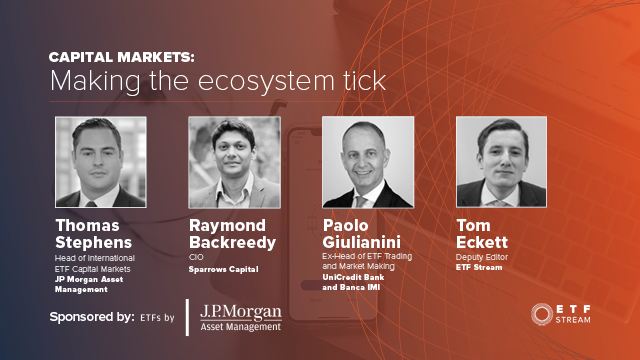The fourth edition of
ETF Stream’s
webinar series, ETF Ecosystem Unwrapped, focused on the how the ETF wrapper behaved during the coronavirus turmoil, fragmentation issues in Europe and the impact regulation has had on improving market efficiency.
The conversation began with a discussion on whether the all-time-high discounts seen for some fixed income ETFs during the coronavirus turmoil. Thomas Stephens, head of international ETF capital markets at J.P. Morgan Asset Management, said it is more important to frame it from a timed and lag perspective.
“When you look at the net asset value (NAV) and valuation points of an ETF, these are determined by the index providers we work with. It’s worth noting they can have different methodologies in order to arrive at the valuation price for the bonds that underly the ETFs,” Stephens explained.
“The intraday nature of an ETF trading on exchange, as well as some over-the counter (OTC) venues, meant the ETF was acting as more of a barometer for the clearing price, as the ETF moved faster than the pricing levels used in the index.”
Faced with making investment decisions during the widening discounts, Raymond Backreedy, CIO at Sparrows Capital, highlighted the price discovery role ETFs played especially compared to the “archaic” bond market.
Given the growth in assets and trading volumes within the European ETF market, Stephens said this presents a potentially attractive opportunity for authorised participants to join the market.
Paolo Giulianini, ex-head of ETF trading and market making at UniCredit Bank and Banca IMI, said there has been numerous cycles of competition for market makers and it is a healthy ecosystem where participants can come in and out but the “technology development is crucial” to support this.
ETF Ecosystem Unwrapped: Key ETF focuses for European regulators
An area where the European ETF market has room for improvement however is the introduction of a consolidated tape. Stephens emphasised its introduction could further advance MiFID II’s improvement to transparency and enable quality and consistent data for ETF trading across different jurisdictions.
As an example, Backreedy said: “An ETF could be available on the London Stock Exchange but also be listed on any other of the 25 exchanges in Europe as well as OTC.
“What the UK investor is seeing is only a fraction of the ETF trading. The consolidated tape would enable them to see the trading volume in one place across all trading venues.”
Giulianini said Europe is close to seeing a consolidated tape being introduced and that regulators are aware of the demand adding it is just a matter of time for them to provide a regulatory-driven solution.
One solution already being implemented in Europe is CSDR. As a result, there is potential for participants’ behaviour to adjust to how they price cash bonds and cash equities, according to Stephens. This is a result of technical concerns that numerous trading bodies have voiced to the European Commission and European Securities and Markets Authority (ESMA).
Stephens said factors such as ETF lending, venue choice and transparency items combined with CSDR and MiFID II will continue an orderly and organised ETF trading ecosystem.
CSDR is also regulators’ bid to encourage a more even playing field between lit venues and MTF RFQ platforms. This enables all transactions, on-screen and OTC, to follow the same “delay settlement penalties and buy-in” regime and using updated technology that tracks the settlement data, according to Giulianini.
“We are starting to see some RFQ platforms that can include the on-exchange liquidity interaction with a sweep functionality similar to what happens in the USA so this is definitely a positive step where an order that sits in a lit venue can be fulfilled out of an RFQ trade.”
The use of certain platforms, however, has limited the adoption of ETFs by the retail and advisor audience in the UK. Backreedy said this is one of the biggest problems the UK market faces.
Backreedy said: “The UK retail market is heavily served by independent financial advisors (IFAs) which tend to use established platforms with large assets under management, however, these platforms offer active funds and ETFs are yet to transition onto them.
“Reasons for this include issues with the underlying technology that is driving these platforms and there is a lack of education for the clients who do not understand the benefits of using ETFs.”
Sign up to ETF Stream’s weekly email here





